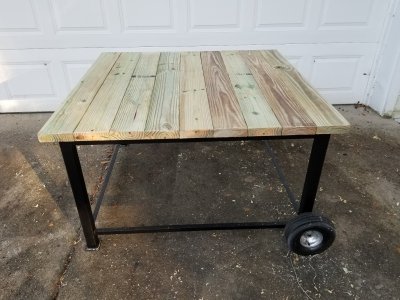I owned and ran a commercial, custom woodworking shop, for over 20 years. I made several bench tops like that and many other butcher-block type laminations, countertops, curved laminations etc.
2X4s do make for a very sturdy top.
However;
The best top bench top surfaces I found for both, general wood and metal work is Formica aka Plastic laminate or just laminate. This material is actually a phenolic laminate, made with paper and phenolic & melamine resin. It is very hard, durable and easy to clean, even dry wood glue pops off easily. These tops are also fairly quick and simple to make; 2 layers (If you want more mass you could use 3 or 4 sheets) of particle/flake board or MDF laminated together and the formica laminated on both top and bottom make for a very flat, hard and stable surface. It is very important to laminate the bottom otherwise the top will bow/warp with changes in humidity. There is even plain, non printed, laminate available just for this purpose. I used ¾" hardwood (usually Hard Maple) for the perimeter edges.
The laminated solid wood tops are best for very heavy work. They it also have the advantage that you can screw into it for blocking, jigs etc. I know some folks are rolling their eyes at that thought but in a commercial shop no one cares about such things, just getting the job done.
If you do go that route my two cents are;
Best to use Hard Maple but if using 2x4 stud go with KD, Southern Yellow Pine or Douglass Fir, avoid the "White Wood" spongy, studs. if you want one pice laminations, It's worth the effort to take your time picking through the lumber racks and select the straightest 2x4s, with at least one knot free edge for the top side, (small tight knots are okay) You can often even find a couple almost completely clear pieces if you are diligent, save those for the outside edges. Another strategy is to cut out the knots and stagger the interior joints.
It's best to first true the 2xs on a jointer, then run them through a thickness planer. Alternately, you can also true the edges on a table saw by fastening the 2xs temporally to a straight board, ripping off an edge, then ripping them parallel.
Glue up is a problem, as most woodworking glues set-up fairly quick and with so many joints it is hard to get it all spread aligned and clamped before some sections are starting to grab. A small paint roller helps with the application and a second set of hands is always good. Slow setting epoxy is best but is expensive. Don't use the Yellow Wood glue as it is too thick, use white glue, it will squeeze out better and has more open time.
Another approach is to assemble a few layers at a time, then join the sections together.
The threaded rod method is good if you don't have enough clamps and for exterior bench tops.
Of course the best way to true the top is to run the whole thing through a planer or wide belt sander, as I did but those machines usually not available. So carful set up when clamping, on a flat level surface is key. The guy in the video, working on two wobbly sawhorses is NOT the best way to go IMHO. I could go on...
Truing the top could be done by hand or power plane and a belt or random orbit sander.
Finish with several coats of urethane, top and bottom. Keeping the top waxed will help keep glue from sticking.

